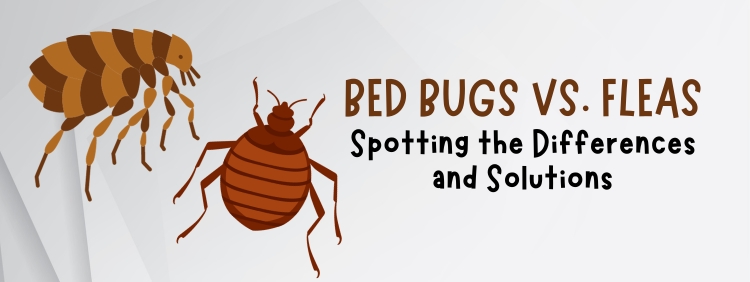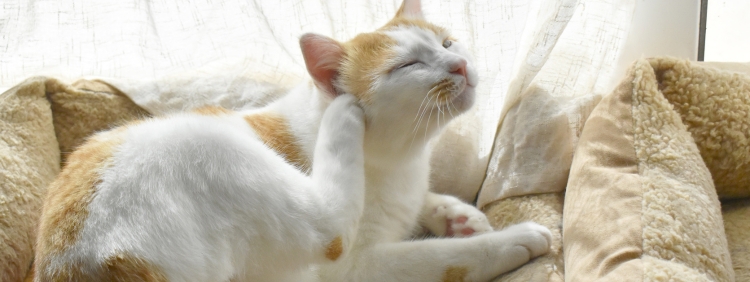Bed Bugs Vs. Fleas in Guelph: Spotting the Differences and Solutions

It’s no secret that there’s a certain discomfort that washes over you when you spot tiny creatures crawling around your home in Guelph. Instantly, one question races across your mind: ‘Is it bed bugs or fleas?” These pests might be small in size, but they indeed pose significant problems- for your comfort and health.
This article intends to help you distinguish between the elusive bed bugs and the notorious fleas. We will delve into their basic characteristics, habits, appearance, and favourite hiding spots. Let’s assemble all the clues necessary to successfully identify the culprit behind those nasty bites. Then, we’ll look at when to call for a professional bed bug exterminator in Guelph and other pest control services.
Understanding Bed Bugs And Fleas
Key Differences
- Bed Bugs: Cimex lectularius, more commonly known as bed bugs, are minuscule insects that feed on human blood during the night. Normally less than a quarter-inch long, these pests possess a flat oval shape and a reddish-brown hue. When these little vampires bite, they insert an anesthetic, which results in painless feedings, often going unnoticed until the itching starts.
Bed bugs have an uncanny ability to hide in the most obscure places, such as behind wallpaper, under carpets, or within mattress seams. Yet, they also fancy living close to humans because we are their primary food source. These critters were almost wiped out in the 1940s before making a comeback in the last two decades, becoming a growing concern for people in Guelph and around the world.
- Fleas: Ctenocephalides felis or Ctenocephalides canis, known as cat and dog fleas, respectively, are another significant nuisance. These insects, tinier than bed bugs, make up for their size with their infamous jumping abilities. A flea can leap up to 200 times their body length, making it an Olympic long-jumper in the insect world! These insects also prefer warmer environments, making homes with pets (like cats and dogs) pristine targets. They feed on the warm blood of their hosts and lay eggs in their fur. They cause itching and discomfort, inducing excessive scratching and possible skin infections in pets.
Identifying the Differences
Despite both being a nuisance, there are distinct differences between bed bugs and fleas that can assist in their identification.
- Appearance: Bed bugs are flat, oval-shaped, and reddish-brown. They have small, wingless bodies, typically growing only up to 5mm long. Fleas, on the other hand, are dark brown or reddish-black and are even smaller than bed bugs, measuring in at about 3mm long. They possess six elongated legs, aiding them in their impressive leaps.
- Behaviour: Bed bugs are nocturnal pests, feeding on humans while they sleep. They often hide within mattress seams, cracks, crevices, or any other obscured spaces near their hosts. They’re not known for their agility, mostly crawling to their host for feeding. Fleas, contrasting, are quite active and can perform extraordinary leaps from host to host or from the environment onto the host. They primarily target pets but will bite humans if pets are not available.
- Bites: The bites of these pests are another clear identifying factor. Bed bug bites are often found in linear or clustered patterns on exposed skin areas while sleeping. Bites are initially painless but cause itchiness and irritation later on. Flea bites are more randomly distributed and primarily targeted towards the lower leg areas in humans. They cause an immediate reaction, leading to intense, persistent itching.
- Lifecycle: Bed bugs have a straightforward life cycle: egg, nymph, and adult. Each stage requires a blood meal before progressing to the next. Fleas have a more complex life cycle, including eggs, larvae, pupae, and adults, all requiring specific conditions.
Signs Of Infestation: Clues To Unwanted Guests
To get rid of these tiny invaders, recognizing the signs of their presence in your home is crucial. They both leave unique trails that reveal their infestation.

For Bed Bugs:
- You might notice small bloodstains on your sheets and pillowcases, resulting from their midnight feedings.
- Bear in mind that bed bug excrement leaves behind dark or rusty spots on mattresses or bedding. It is often found around the areas where they hide.
- They might also shed their skin as they grow, resulting in tiny, yellowish husks, which are usually discovered around their living quarters.
For Fleas:
- Identifying a flea infestation might be easier as your pet starts to scratch incessantly. But this isn’t the only sign.
- Flea droppings, also known as flea dirt, have the appearance of ground black pepper. Look for these on your pet or in its bed.
- You may also find tiny white eggs in your pet’s coat or in the area where your pet sleeps.
Noticing these signs at an early stage can help to nip the infestation in the bud before it becomes a significant menace to both your health and peace of mind.
Health Risks: The Dangers Of Bed Bugs And Fleas
Though bed bugs and fleas might seem like an annoyance, it’s essential to remember that these pests also pose potential health risks.
Bed Bug Hazards
- Bites: One of the most immediate and noticeable repercussions of bed bug infestations is the bites they leave behind. These bites often cause intense itching and can lead to secondary infections if scratched excessively.
- Allergic Reactions: Some individuals may experience an allergic reaction to bed bug bites, which can result in a widespread rash, difficulty breathing, or even anaphylaxis in rare cases. Ensure to seek medical attention immediately if you experience any severe symptoms after a bed bug bite.
- Insomnia: Knowing that bed bugs might be feasting on you while you sleep can result in anxiety and insomnia. Prolonged lack of sleep can contribute to chronic fatigue, irritability, depression, and other mental health issues.
Flea Dangers
- Bites: Similar to bed bugs, flea bites also cause intense itching and discomfort. Flea bites can lead to dermatitis or secondary skin infections due to excessive scratching.
- Zoonotic Diseases: Fleas serve as vectors for several diseases such as plague and murine typhus. Additionally, they can also transmit tapeworm larvae to both pets and humans.
- Severe Infestations: In severe infestations, especially in young or sick pets, fleas can draw enough blood to cause anemia, which can be life-threatening if left untreated.
Undeniably, these potential health risks underline the need to promptly identify and deal with any signs of bed bugs or flea infestations in your home.
Professional Help: When To Call The Exterminator
Making the decision to call in professional pest control services is often driven by the magnitude of the infestation. However, our experts at Truly Nolen always advise to call a professional service at the first sign of a problem.
Do-It-Yourself Treatments:
Early detection and action can sometimes curb these pests’ spread. Simple DIY measures include regular vacuuming and laundering bedding and fabrics at high temperatures. For fleas, regular grooming and flea treatment for pets might help control mild infestations.
However, before you decide to tackle these pesky critters yourself, it’s essential to remember that such attempts may not entirely eliminate these pests, especially if the infestation is more significant than anticipated.
When to Call for Professional Help:
If your attempts to eradicate these pests are ineffective, or if the infestation is widespread, it’s time to call in the experts. Here are some signs that you might need professional help:
- Continued sighting of live bugs or new bites, despite DIY attempts to contain the infestation.
- Rapid and extensive spreading: these pests reproduce quickly – bed bugs, for example, can lay up to five eggs per day. If not quickly addressed, a minor infestation can soon become a full-blown home invasion.
Uncontrollable itchiness or allergic reactions for you or your pet. - The infestation is causing severe distress and affecting your quality of life or mental health.
Truly Nolen professionals bring in their expertise, coupled with powerful heat treatments, insecticides, or fumigation techniques that ensure a thorough extermination of these pest populations. They also provide valuable insights to prevent future infestations and ensure a safer environment for you and your family.
Alleviating The Stress: Getting Ahead Of The Problem
Living with these pests can place an enormous strain on your life. However, with knowledge comes power. Identifying the differences between bed bugs and fleas, recognizing the signs of their infestation, understanding the health risks, and knowing when to call in professional help is your first line of defence against these unwanted visitors.
For flea and bed bug control in Guelph, contact the professionals at Truly Nolen.